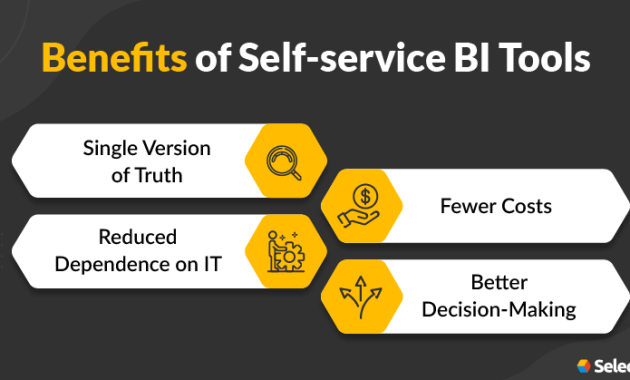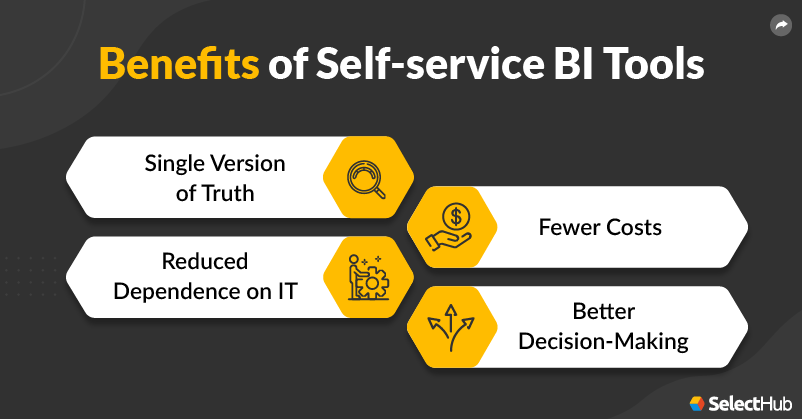
Self-Service Business Intelligence Software: A Cost-Cutting Revolution
In today’s data-driven world, businesses are constantly seeking ways to optimize operations and gain a competitive edge. One of the most powerful tools in this pursuit is self-service business intelligence (BI) software. This software empowers users to analyze data and generate insights without relying heavily on IT or specialized data analysts. The promise? To reduce costs and improve efficiency across the board. This article delves into the benefits, features, and considerations of implementing self-service BI, exploring how it’s reshaping the landscape of business decision-making.
The Evolution of Business Intelligence
Historically, BI was a complex, time-consuming process. Data was siloed, requiring skilled data scientists and IT professionals to extract, transform, and load (ETL) data. These experts then built reports and dashboards for business users. This approach was often slow, expensive, and created bottlenecks. The emergence of self-service business intelligence software has fundamentally altered this paradigm. It empowers business users with the tools they need to explore data independently, fostering agility and responsiveness.
Key Benefits of Self-Service BI
The advantages of adopting self-service business intelligence software are numerous and impactful:
- Reduced Costs: This is the primary driver. By enabling users to perform their own analysis, businesses reduce costs associated with hiring and maintaining large teams of data analysts and IT specialists. Less reliance on external consultants further contributes to cost savings.
- Faster Insights: Users can access and analyze data in real time, leading to quicker identification of trends, anomalies, and opportunities. This speed allows for more agile decision-making and faster responses to market changes.
- Improved Data Literacy: The intuitive interfaces of self-service business intelligence software encourage data exploration. This fosters a culture of data literacy, where users become more comfortable working with data. This ultimately leads to better decision-making across the organization.
- Increased Productivity: Business users can answer their own questions without waiting for IT or data specialists. This frees up valuable time and resources, allowing them to focus on core business activities.
- Better Collaboration: Self-service business intelligence software often includes features for sharing dashboards and reports. This promotes collaboration and knowledge sharing across teams and departments.
Core Features of Self-Service BI Software
Modern self-service business intelligence software offers a range of features designed to empower users. These features are crucial for its effectiveness:
- Data Integration: The ability to connect to various data sources is essential. This includes databases, cloud services, spreadsheets, and more. Robust data integration capabilities ensure users can access all relevant data.
- Data Preparation: Users need tools to clean, transform, and prepare data for analysis. This includes features like data profiling, cleansing, and transformation.
- Data Visualization: Intuitive dashboards, charts, and graphs help users understand data quickly and easily. The ability to customize visualizations is crucial.
- Interactive Dashboards: Users need to be able to drill down into data, filter, and explore different perspectives. Interactivity is key to gaining deep insights.
- Reporting and Sharing: The ability to create and share reports is essential for communicating findings and collaborating with others. Reporting features should include the ability to schedule reports and send alerts.
- Mobile Access: Increasingly, users need to access their data on the go. Mobile access ensures that insights are available anytime, anywhere.
Selecting the Right Self-Service BI Software
Choosing the right self-service business intelligence software is critical for success. Careful consideration of several factors is necessary:
- Ease of Use: The software should be intuitive and easy to learn. The goal is to empower business users, not to require extensive training.
- Data Connectivity: Ensure the software can connect to all relevant data sources. This is fundamental to the value of the software.
- Scalability: The software should be able to handle growing data volumes and user needs. Consider the future growth of your business.
- Security: Data security is paramount. The software should offer robust security features to protect sensitive information.
- Cost: Evaluate pricing models and ensure the software fits within your budget. Consider both upfront and ongoing costs.
- Support and Training: Look for software providers that offer good support and training resources. This will help your users get the most out of the software.
Real-World Examples of Cost Reduction
Numerous businesses have successfully implemented self-service business intelligence software and realized significant cost savings. These examples illustrate the tangible benefits:
- Retail: Retailers use self-service business intelligence software to analyze sales data, identify slow-moving products, and optimize inventory levels. This reduces waste and improves profitability.
- Manufacturing: Manufacturers use it to monitor production processes, identify inefficiencies, and reduce downtime. This leads to lower operating costs.
- Healthcare: Healthcare providers use it to analyze patient data, improve resource allocation, and reduce costs associated with unnecessary procedures.
- Finance: Financial institutions use it to analyze financial performance, identify fraud, and improve risk management. This leads to better financial outcomes.
- Marketing: Marketing teams use it to analyze campaign performance, optimize ad spend, and improve customer acquisition. This leads to higher ROI.
The Future of Self-Service BI
The evolution of self-service business intelligence software is ongoing. Several trends are shaping the future:
- Artificial Intelligence (AI) and Machine Learning (ML): AI and ML are being integrated into BI tools to automate tasks, provide predictive analytics, and generate insights. This will further enhance the capabilities of self-service business intelligence software.
- Cloud-Based Solutions: Cloud-based BI solutions are becoming increasingly popular due to their scalability, flexibility, and cost-effectiveness. The cloud is becoming the standard.
- Data Democratization: The goal is to make data accessible to everyone in the organization. Self-service business intelligence software plays a crucial role in this process.
- Focus on Data Governance: As more users access data, the need for strong data governance becomes more critical. This ensures data quality and compliance.
Implementing Self-Service BI: Best Practices
Successful implementation of self-service business intelligence software requires careful planning and execution. Consider these best practices:
- Define Clear Objectives: Determine what you want to achieve with the software. Identify specific goals and metrics.
- Assess Data Readiness: Evaluate the quality and accessibility of your data. Clean and prepare your data before implementation.
- Choose the Right Software: Select software that meets your specific needs and budget. Consider the factors mentioned above.
- Provide Training and Support: Train users on how to use the software and provide ongoing support. This is critical for user adoption.
- Establish Data Governance: Implement data governance policies to ensure data quality and security. This protects your data.
- Iterate and Improve: Continuously evaluate the effectiveness of the software and make adjustments as needed. This helps to optimize its use.
Conclusion: Embracing the Power of Data
Self-service business intelligence software is a powerful tool for businesses seeking to reduce costs, improve efficiency, and gain a competitive edge. By empowering users to analyze data and generate insights, this software fosters a data-driven culture. Businesses that embrace self-service business intelligence software are better positioned to make informed decisions, respond quickly to market changes, and achieve their business goals. The potential for cost savings and improved performance makes it an essential investment for any organization looking to thrive in today’s data-driven world.
[See also: Choosing the Right BI Software, Data Visualization Best Practices, Building a Data-Driven Culture]

